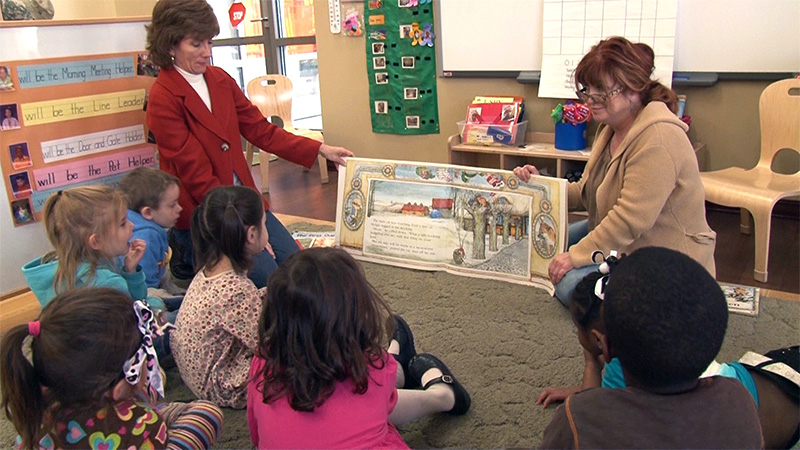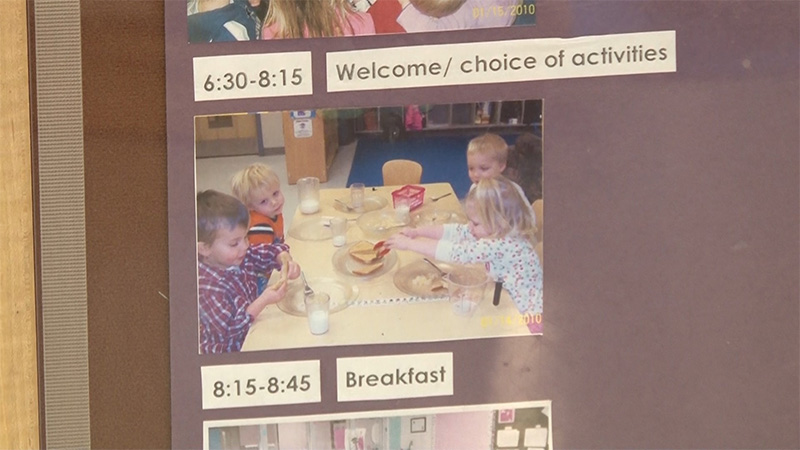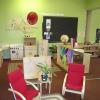- Teach staff members the components of an effective schedule.
- Model strategies for providing structured, yet flexible, schedules during interactions with adults.
- Observe and provide feedback on schedules and routines.
Learn
Teach
Take a moment to think about your day today. What if you arrived at your place of work and were told, “You’ll be starting at a different time today. Your hours today will be 11:45 a.m. until 7:00 p.m. We also need you to go to a different location. We need you to work with a teacher in the infant classroom in Building B. When you come here tomorrow, you may be working at a different location again. I will let you know.”
How would you feel? How might your feelings affect your ability to feel productive and confident? How will your feelings affect your behavior with the teacher and infants in the classroom you visit? How does this apply to children’s and staff members’ feelings and behaviors in settings with varying and unpredictable schedules and routines?
Young children are only just beginning to develop the concept of time, so they organize themselves by the people they are with and the events that happen. When things happen in the same order each day, children have a better understanding of their world and feel more secure. A predictable schedule filled with consistent and responsive routines helps them to know what to expect and helps them feel more confident in themselves and the world around them. It also helps develop a sense of belonging: children learn “I belong here” and “I am safe here.” This is true for all children, but it is particularly important for children who have experienced trauma. You can read more about this in the Focused Topic course on Trauma-Informed Care in Childcare Settings in Childcare Settings. For now, it is important to know that children, families, and staff who have experienced trauma thrive with predictable care. The content in this lesson will help you and staff maintain the consistent care that all children and families need.
Components of An Effective Schedule
The daily schedule will look different across age groups. The schedule in an infant room, for example, should follow the needs of the infants in that room. School-age youth may take a leadership role in establishing a schedule that meets the needs of the group and individuals. Across the age groups, there are several consistent elements that you can help staff develop in their schedules:
Child-directed time: Across all age groups, a substantial portion of the programming day (i.e., at least one-third of the time the facility is open) should be dedicated to free-choice time. Especially in school-age programs, it is important to provide adequate time for children to engage in free-choice, unstructured activities. Most of their school day is highly structured, so this can be an important time to unwind and choose enjoyable activities on their own or with friends. Child-directed time is an opportunity for adults to join play, engage in rich discussions with children, observe children’s learning, and promote interactions between children. Adults can also scaffold children’s learning by offering new ideas or introducing a challenge.
Adult-guided activities: In most of the classrooms you support, some form of adult-guided large-group time will occur. For infants and toddlers, mandatory adult-directed activities are not developmentally appropriate. However, staff members can still offer “a group time” as a way to strengthen their classroom community, asking the children to come together to share songs or ideas (e.g., copying the motions of infants and toddlers; Lang et al., 2010). Infants and toddlers should be able to be active participants during group time, which should be short, perhaps five to 10 minutes. It is appropriate to offer infants and toddlers the choice to engage in this time and to offer stories, songs, or group activities with an adult and small group of peers at different points throughout the day
For preschoolers, group times should be kept to 15 to 20 minutes or less. this can be a chance to read stories to the group, discuss the daily schedule, and build classroom community. . . In school-age programs, adult-directed activities may be optional and may take a variety of forms: an opportunity to learn how to build model airplanes, a science experiment, or a structured outing. School-age programs may also offer a variety of optional group activities, like acting out a play, doing community service work, or playing sports.

Outdoor time: As described in Lesson 3, outdoor time is a rich opportunity for learning. Encourage staff to bring the curriculum outdoors. Make sure that you observe outdoors, so staff recognize its importance and receive feedback about outdoor programming.
Routines and caregiving: For infants and preschoolers, a large portion of the day is spent in routines and caregiving. This includes meals, snacks, rest, and self-care routines like diapering, toileting, and toothbrushing. During these routines, staff should spend time talking with children, comforting children, and building relationships. They should work with families to understand the routines children experience at home, what families expect, and how families like to comfort their child
Transitions: In all program spaces, children will transition from one activity to another. Work with staff to make sure transitions are short and clear. Help children know what to do during transitions (where are they going? How should they get there? What do they do when they get there?). Whenever possible, work with staff to identify and eliminate unnecessary group transitions that involve wait time for children.
Communicating the Daily Schedule and Routines
How staff talk about the schedule with children makes a difference in how children feel. Staff should refer to the schedule throughout the day. Simple phrases like, “We’re all done with breakfast. Let’s check our schedule to see what comes next” can help build predictability and confidence. While predictable schedules are important, staff are not powerless to make changes. Help staff make decisions about when to change the schedule and how to share those changes with children and youth. For example, if the weather prevents children from going outside, staff can share that with the children early in the day and place a picture of the indoor gym on the classroom picture schedule.
For children, especially those with dis/abilities, pictures that help support their successful engagement in routines can be incredibly helpful. A picture schedule can help children understand the order of activities across a day. Pictures can also help children understand individual routines. For example, staff may display a small series of pictures near the sink to remind children about the necessary hand washing steps. Or, perhaps near the snack table, there is a small series of pictures that reminds them about the important steps before (e.g., washing hands, gathering napkin) and after (cleaning up space, throwing trash away) having snack. See more information from Kids Included Together on how to support all children in your setting.
Model
Staff meetings and professional development events (trainings) are an opportunity to model predictable schedules and routines. Think about how staff meetings are organized and managed; you might work with your program’s manager to make sure staff meetings reflect your program’s commitment to structured, yet flexible, schedules. Collaborate to design a meeting structure that balances staff-directed and management/trainer-directed elements. For example, effective meetings may begin with active opportunities to check-in socially amongst staff and to generate questions or priorities. Make sure staff members receive an agenda before the meetings and that meetings always begin and end on time. Make sure mechanisms are in place for staff members to share their needs and opinions related to staff meetings (e.g., have staff members write ideas or questions on sticky notes to be read at the end of the meeting or use an anonymous feedback box). Use the concepts from this lesson when or if you provide group professional development events: Provide a mix of activities, let participants know what the schedule will be (and when restroom breaks and meals are), and be responsive to the feedback participants give you verbally and through body language. If adults look bored, it’s time to make a change.
Provide new staff members with sample schedules they can use as models for creating their own learning experiences for children. It can be helpful to have materials available in the training room for staff to work on their schedules. Make arrangements for them to visit other classrooms or programs for ideas. Make sure staff members know that they need to communicate their schedules with children and with adults. That is, they will always need to create two schedules: a simple one appropriate for the children in their care and a more detailed schedule for other staff members or families. They also make individual picture schedules for specific children or routines.

Observe
It is important to help staff members think about ways to use their time efficiently to maximize learning. Let’s watch a cooking activity with toddlers. How would you help the staff member brainstorm ways to refine this activity?
Case Study: Schedules and Routines
Now consider what a coach might say and do after this observation:
See | You Saw:
|
|---|---|
Say | What You Might Say:
|
Do | What You Might Do:
|
Additional Examples of Learning Environments
For infants and toddlers, it's important to offer short, child-initiated learning experiences. Let's watch a video on how effective schedules and routines promote cognitive development for very young children.
Infants & Toddlers: Promoting Cognitive Development
Use the menu at the left or the pager below to cycle through scenarios
See | You Saw:
|
|---|---|
Say | What You Might Say:
|
Do | What You Might Do:
|
See | You Saw:
|
|---|---|
Say | What You Might Say:
|
Do | What You Might Do:
|
See | You Saw:
|
|---|---|
Say | What You Might Say:
|
Do | What You Might Do:
|
A Range of Preschool Schedules and Routines
Use the menu at the left or the pager below to cycle through scenarios
See | You Saw:
|
|---|---|
Say | What You Might Say:
|
Do | What You Might Do:
|
See | You Saw:
|
|---|---|
Say | What You Might Say:
|
Do | What You Might Do:
|
See | You Saw:
|
|---|---|
Say | What You Might Say:
|
Do | What You Might Do:
|
A Range of School-Age Schedules and Routines
Use the menu at the left or the pager below to cycle through scenarios
See | You Saw:
|
|---|---|
Say | What You Might Say:
|
Do | What You Might Do:
|
See | You Saw:
|
|---|---|
Say | What You Might Say:
|
Do | What You Might do:
|
Explore
In your work as a trainer or coach, you may come across staff who struggle with effective scheduling. Read the scenarios in the Scheduling Scenarios activity, and decide how you would respond. Then compare your answers to the suggested responses.
Apply
The National Center for Pyramid Model Innovations (NCPMI) has developed helpful resources for developing and communicating schedules in early childhood classrooms. There are also tips and templates that may be adapted for school-age children. Download and print the Visual Support Guide from the NCPMI website to share with staff.
Consider using the Schedules and Routines Best Practices Checklist to observe and document competencies that specifically address appropriate schedules and routines. Share your observations with staff and use the information learned from the checklist to identify goals and focus your coaching interactions.
Glossary
Demonstrate
Better Kid Care. Creating a sense of place: Considering routine, ritual, and belonging. https://extension.psu.edu/programs/betterkidcare/early-care/tip-pages/all/creating-a-sense-of-place-considering-routine-ritual-and-belonging
Dodge, D. T., Colker, L. J., & Heroman, C. (2016). The creative curriculum for preschool (6th ed.). Washington, DC: Teaching Strategies, Inc.
Early Childhood Learning and Knowledge Center (2020). The importance of schedules and routines. to open link in a separate tabhttps://headstart.gov/about-us/article/importance-schedules-routines
Education Development Center. (n.d.). Integrating technology into learning checklist. https://www.edc.org/sites/default/files/uploads/Integrating-Technology-Checklist_English.pdf
Gillespie, L., & Peterson, S. (year). Rituals and routines: supporting infants and toddlers and their families. Zero to Three.
Jordan, C., Parker, J., Donnelly, D., Rudo, Z. (Eds.). (2009). A practitioner’s guide: Building and managing quality afterschool programs. Austin, TX: SEDL. to open link in a separate tabhttps://sedl.org/afterschool/practitioners_guide_to_afterschool_programs.pdf
Lang, S. N., Aledia, T., Casey, K., & Kirkbride, K. (2010, April). Infant/Toddler group time: A time for creating & sustaining classroom culture. Presentation at Ohio Early Care & Education Conference, Columbus, OH.
National Center for Pyramid Model Innovations (2020). Visual supports for routines, schedules, and transitions. to open link in a separate tabhttps://challengingbehavior.cbcs.usf.edu/docs/Routine_cards_home.pdf
National Institute on Out-of-School Time. http://www.niost.org/
Robb, M., Catalano, R., Smith, T., Polojac, Figlar, M., Minzberg, B., & Shomburg, R. (n.d.) Checklist for identifying exemplary uses of technology and interactive media for early learning. The Pennsylvania Digital Media Literacy Project.
Statman-Weil, K. (2015). Creating trauma-sensitive classrooms. Young Children, 70 (2). Wellesley Centers for Women at Wellesley College.


